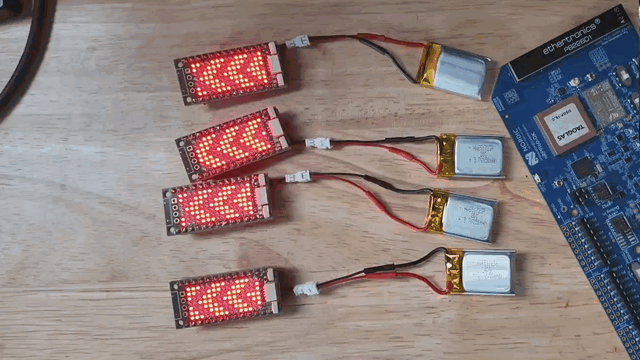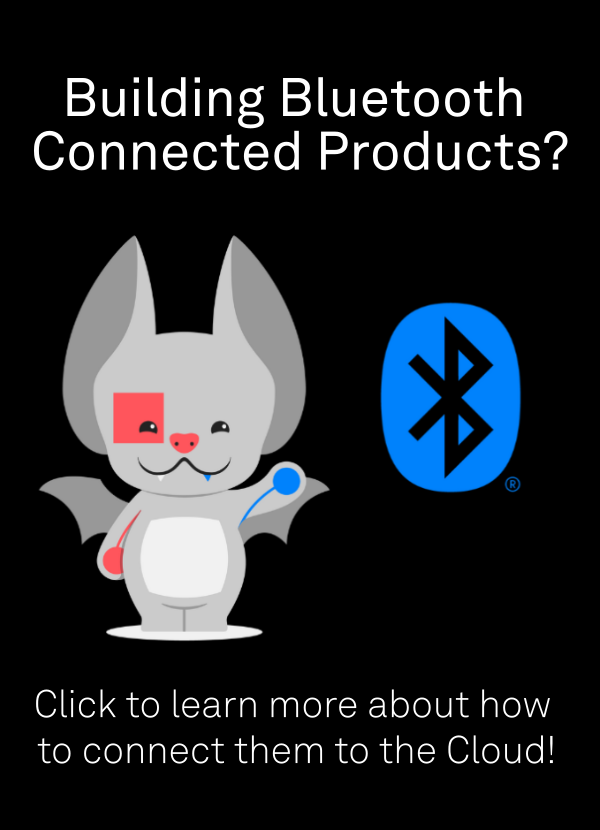In my many years of making demonstrations, I have found that blinky almost always wins. LEDs naturally draw the eye. With the upcoming release of Golioth’s Bluetooth-to-Cloud, I knew we would also need to create a large amount of node devices to showcase many devices connecting through a gateway. I wanted a reasonable per-node cost, and interesting input and output capabilities.
So I did what I normally do, despite it not always being the best idea: I fired up KiCad and started creating a new design. As luck would have it, I found a design that has a potential to make a versatile, compact node for demonstrating Bluetooth control and communication to the cloud. As we’ve done with our other hardware at Golioth, today we’re open sourcing this design as well.
Check out the Tikk hardware design on GitHub or view the files directly on KiCanvas

Start from low cost ecosystems
There have been standardized form factors since before Arduino popped on the scene with the Uno header in 2007. In that time, electronics costs have dropped through the floor. We continue to relish in these ad hoc standards, adopting things like the MikroBus Click header standard on our Aludel Elixir board (also open source) and utilizing Uno-to-Click converters to make those same designs even more accessible with our “Follow Along Hardware”, which uses a range of development kits and Zephyr’s flexible pin assignments to adopt hardware to a range of vendor hardware.
For this design, I wanted to go smaller. Not quite as small as on the AirTag clone (Orleon), but smaller than an Uno or Click header would allow. Instead, I was clued into a ProMicro clone that includes the nRF52840 chip, one of the many that works with Zephyr and Golioth’s Bluetooth-to-Cloud. Surprisingly, the board can be shipped to a house in the US from a factory in China with tariffs included (somehow) for $3. OK, you need to buy two, but that’s fine with me, I bought a lot more than that. Why this low price point? They’re targeting the keyboard builders of the world, many of whom adopted the ProMicro form factor (rumor has it that some keyboard enthusiasts roam the virtual halls of Golioth, as well!). This board has USB, the chip and RF front end/passives, battery charging, power regulation/control, status LEDs, and 26 breakout pins in a 2×13 pattern. That’s enough for just about anything I might want to do with tiny boards, though the board maker did leave a lot of pins unused on the nRF52840 (I hate to see unused pins, there are just so many on that part!)
What this board didn’t have? Much of anything interesting to alert a user that things were happening inside the Bluetooth part. So let’s build a demo board to attach to it.
How many LEDs?
Sure, blinking an LED from the cloud is cool and impressive when transiting the various systems we transit. But what if we blinked a lot of LEDs? And put them all in order. Perusing the available chips from LCSC (more on that later), I found a familiar chipset: the IS31FL3731. It’s a 9×16 LED matrix display with an optional audio input that can match the pulse of input audio. It’s targeted at EQ displays for stereos, but also makes a fun way to display text, graphics, and whatever else you can dream up…but maintaining that “Times Square in the 80s” kind of look.
This board has 105 LEDs in a 7×15 matrix, basically the most I could fit onboard with 0402 LEDs in the available space. The 7 pixels high is a crucial number to fit a minimalist 7×5 pixel font size. The I2C driver allows control of individual LEDs and has framebuffers to allow animations without regular interaction with the driver chip; you set up the frames and away you go. Easier said than done, but Mike Szczys made short work of the driver in Zephyr and plans to upstream it at some point as well.
An exercise in low(er) cost
In the face of US tariffs, getting any custom electronics made right now can be tricky. The supply chain is inexorably tied to other countries, especially China, even if we decided to do domestic production. I couldn’t find what I needed on US marketplaces at the price point I wanted, so instead I decided to lean into lower cost parts (LCSC) and assembly (JLC) and then pay the tariffs. As such, the parts on this board were largely informed by what I could get on that marketplace and what fit onto the somewhat limited size of the board. Here are the features/part names:
- 105 LEDs in 0402 format, individually addressable in a 7×15 matrix with the IS31FL3731
- Two H-Bridge chips (L9110S) for driving a single stepper or two dc motors
- 3 axis accelerometer (LIS2DH12)
- Temperature sensor (TMP102)
- QWIIC / Stemma header to expand breakout boards*
- User button
- Reset button
- A voltage divider that monitors battery voltage
Additional capabilities added by the Tenstar ProMicro and nRF52840
- Additional GPIOs I can solder to (5 digital, one analog)
- LiPo battery charger on board
- Load switch for all peripherals except motor driver
- USB Input to the nRF52840 (get serial terminal using USB-CDC)
- NFC tag emulation (via the nRF52840 and onboard flex connector)
Shield your eyes, demos are on the way
This board will highlight the various Golioth Bluetooth-to-Cloud capabilities by making it blindingly obvious when a configuration change has been sent down to a device. The less outwardly obvious demonstrations like OTA and Cloud side data will follow our normal display format, but are just as intriguing when done over a Bluetooth link without any custom code on the intermediary device. Stay tuned for more demos here or reach out on the forum to let us know what we should build!

* As happens with some Rev A boards, the QWIIC header got miswired, so this is currently backwards (but fixable with a cable mod) and will be fixed in Rev B


No comments yet! Start the discussion at forum.golioth.io